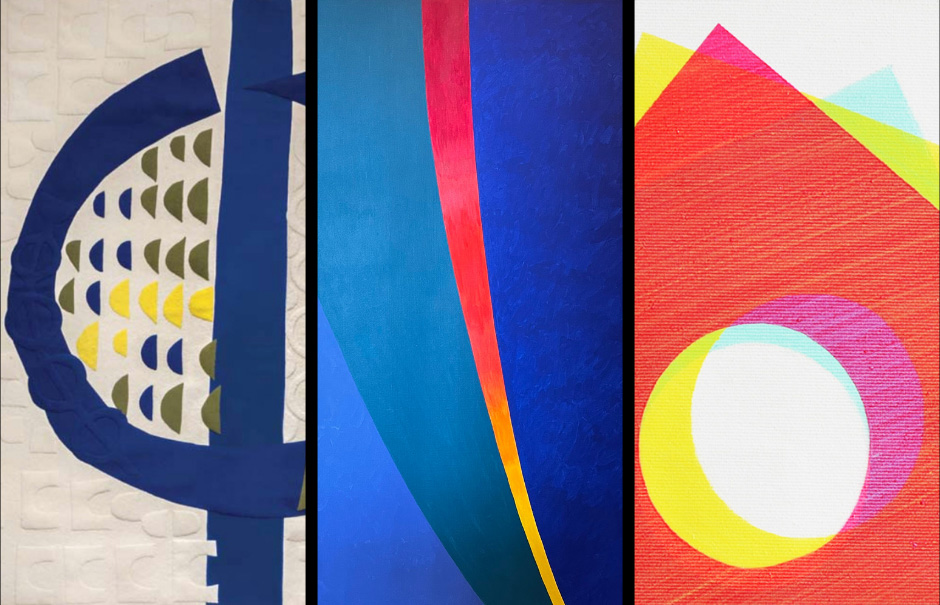
Gabriella Hajnal / Eszter Kass / Eszter Poroszlai
2023. augusztus 31 - szeptember 29.
According to the philosopher Lajos Szabó, "reality is given in perspectives." With Maszó, there is no single perspective, only a multiplicity of perspectives, a series of perspectives that offer insight into the complexity of reality, the richness of the world. And understanding requires shifts, changes of perspective and different experiences that reveal differences. The exhibition at The Space offers the viewer an opportunity to reflect on the role of shifting perspectives in art; three artists from different generations, each with a very different relationship to the textile tradition, present in this exhibition a particular, non-genre-specific abstraction, or rather a condensed cosmological perspective, offering evidence that an artistic phenomenon is of higher quality the greater the tension between its openness and its self-containedness.
Gabriella Hajnal (1928) a magyarországi kárpitművészet kiemelkedő alkotója festőként végzett a Képzőművészeti Főiskolán 1957-ben és rögtön váltott a gobelin készítésre: „Élveztem, hogy a függőleges felvetés és a vízszintes szövés szigorú kalodájának keretei között mozoghatok csak, ezen belül kell a legjobb lehetőséget megtalálnom a mondanivalómhoz.” – írja Hajnal, akinek alapvető élménye volt a párizsi Cluny Múzeumban a Hölgy egyszarvúval című kárpitsorozatával való találkozása. Hajnal évtizedről évtizedre haladt a maga egyéni absztrakciójának útján, korai kárpitjai még meseszerűek voltak, majd régi történelmi korok inspirálták, míg a 70-es évekre elérkezett egy minimálista motívumvilágú, tiszta szerkezetű gobelinfelfogásig, amelyben a káprit szövés több évszázados hagyománya egyben a kísérletezés terepévé is válhatott. A kiállításon szereplő, három darabból álló Egyensúly című (1979) varrott filcgyapjú alkotások épp Hajnal experimentális felfogásának tanui. A körformát kettészelő vonal jelképi sűrűségű motívumra redukált tömör fogalmazásmódja, valamint a néhány visszafogott árnyalatra szorítkozó színvilág a hajnali életműben szinte egyedülálló absztrakcióról tanúskodik. Kitekintés egy megváltozott nézőpontból.
Kass Eszter (1959) followed the opposite path to her mother, Gabriella Hajnal. Eszter Kass graduated from the Department of Textiles at the Hungarian College of Applied Arts in 1984, but it was the state of textile art in Hungary in the 1980s that made her feel like a failure, so she turned to painting. The abstraction of his works is always derived from nature. Enlarged details of organic forms and structures emerge, painted in strong radiant colours. But his series of paintings from 1999 play on the ambivalence that links textile art and fine art in the second half of the 20th century. After all, many contemporary artists consciously evoke and quote textiles in their canvases, and the exciting factorial and symbolic possibilities of different materials, fabrics and weaves have long since infiltrated the painters' motif library. In Eszter Kass's brilliantly coloured works, it is as if pseudo-pachworks, as if the seams of quilting, the needlework, the meeting of different qualities of materials were the main theme of her oil paintings.
Eszter Poroszlai (1974) a trió legfiatalabb tagja jutott legmesszebb a textil műfajának szabad és konceptuális átértelmezésében. Poroszlai egész eddigi munkásságában a tér lehetséges újradefiniálásának és a távlat viszonylagosságának lehetőségeit vizsgálja, mindezt egy minimalista, de folyamatosan kísérletező művészi eszköztárral. Legújabb kísérletei az egyedi fotó és -nyomat világába vezetnek, a transzparencia és a forma elmozdulásán alapuló kombinatorikai variációk feltérképezésén keresztül. A 2021 óta gyarapodó Insta(nt)llation című sorozata a legrégebbi fotóeljárást, a cianotípiát alkalmazza, amely során a napfény segítségével lehet képet alkotni. A vászonra projektált gömbforma precíz geometriája kerül ellentétbe az analóg eljárásból fakadó festőiséggel. Poroszlai már évek óta alkalmazza a fonál hímzést, mint struktúrateremtő elemet fotóin és nyomatain, ebben a sorozatban a kozmoszt jelképező háttér ciánkék színe kerül izgalmas dialógusba a gömb belső törvényeit feltáró neonrózsaszín fonalrendszer interferenciájával. A Layers-sorozat az elmozdulás során létrejövő szín- és forma kombinációs lehetőségeit vizsgálja. A színes (kék, sárga és magenta) négyzetek – melyek közepén kör alakú lyuk jelzi a forgástengelyt – áttetszősége mindig más és más, dinamikusan változó képet eredményez. Poroszlai összetett művészi vizsgálódása harmonizál leginkább Szabó Lajos fent idézett szavaival, „a valóság perspektívákban van adva.”
Noémi Szabó art historian, curator
A kiállítás a Nemzeti Kulturális Alap támogatásával jött létre.

